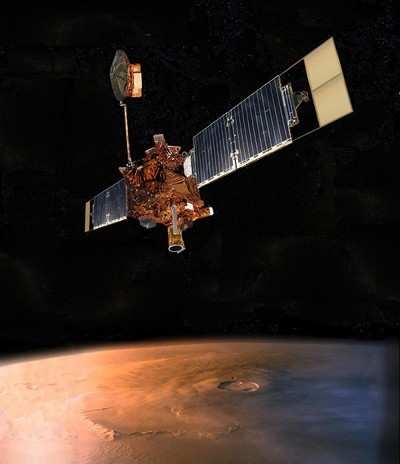Mars Reconnaissance Orbiter Spots Giant Basin On Planet
Surface
New analysis of Mars' terrain using NASA spacecraft observations
reveals what appears to be by far the largest impact crater ever
found in the solar system.

NASA's Mars Reconnaissance Orbiter and Mars Global Surveyor have
provided detailed information about the elevations and gravity of
the Red Planet's northern and southern hemispheres. A new study
using this information may solve one of the biggest remaining
mysteries in the solar system: why does Mars have two strikingly
different kinds of terrain in its northern and southern
hemispheres? The huge crater is creating intense scientific
interest.
The mystery of the two-faced nature of Mars has perplexed
scientists since the first comprehensive images of the surface were
beamed home by NASA spacecraft in the 1970s. The main hypotheses
have been an ancient impact or some internal process related to the
planet's molten subsurface layers. The impact idea, proposed in
1984, fell into disfavor because the basin's shape didn't seem to
fit the expected round shape for a crater.
The newer data is convincing some experts who doubted the impact
scenario.
"We haven't proved the giant-impact hypothesis, but I think
we've shifted the tide," said Jeffrey Andrews-Hanna, a postdoctoral
researcher at the Massachusetts Institute of Technology in
Cambridge.
Andrews-Hanna and co-authors Maria Zuber of MIT and Bruce
Banerdt of NASA's Jet Propulsion Laboratory in Pasadena, Calif.,
report the new findings in the journal Nature this week.
A giant northern basin that covers about 40 percent of Mars'
surface, sometimes called the Borealis basin, is the remains of a
colossal impact early in the solar system's formation, the new
analysis suggests. At 5,300 miles across, it is about four times
wider than the next-biggest impact basin known, the Hellas basin on
southern Mars. An accompanying report calculates that the impacting
object that produced the Borealis basin must have been about 1,200
miles across. That's larger than Pluto.
"This is an impressive result that has implications not only for
the evolution of early Mars, but also for early Earth's formation,"
said Michael Meyer, the Mars chief scientist at NASA Headquarters
in Washington.
This northern-hemisphere basin on Mars is one of the smoothest
surfaces found in the solar system. The southern hemisphere is
high, rough, heavily cratered terrain, which ranges from 2.5 to 5
miles higher in elevation than the basin floor.
Other giant impact basins have been discovered that are
elliptical rather than circular. But it took a complex analysis of
the Martian surface from NASA's two Mars orbiters to reveal the
clear elliptical shape of Borealis basin, which is consistent with
being an impact crater.
One complicating factor in revealing the elliptical shape of the
basin was that after the time of the impact, which must have been
at least 3.9 billion years ago, giant volcanoes formed along one
part of the basin rim and created a huge region of high, rough
terrain that obscures the basin's outlines. It took a combination
of gravity data, which tend to reveal underlying structure, with
data on current surface elevations to reconstruct a map of Mars
elevations as they existed before the volcanoes erupted.
"In addition to the elliptical boundary of the basin, there are
signs of a possible second, outer ring - a typical characteristic
of large impact basins," Banerdt said.
 Airbus Racer Helicopter Demonstrator First Flight Part of Clean Sky 2 Initiative
Airbus Racer Helicopter Demonstrator First Flight Part of Clean Sky 2 Initiative Diamond's Electric DA40 Finds Fans at Dübendorf
Diamond's Electric DA40 Finds Fans at Dübendorf ANN's Daily Aero-Term (04.23.24): Line Up And Wait (LUAW)
ANN's Daily Aero-Term (04.23.24): Line Up And Wait (LUAW) NTSB Final Report: Extra Flugzeugbau GMBH EA300/L
NTSB Final Report: Extra Flugzeugbau GMBH EA300/L Classic Aero-TV: 'Never Give Up' - Advice From Two of FedEx's Female Captains
Classic Aero-TV: 'Never Give Up' - Advice From Two of FedEx's Female Captains



